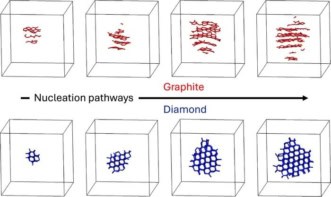
The thermal expansion of graphene and several other 2D materials has been measured at a spatial resolution of just 2 nm. Robert Klie and colleagues at the University of Illinois, Chicago used scanning transmission electron microscopy (STEM) to explore the thermal properties of the technologically-significant materials. Their work could play a key role in the development of electronic components including solar panels and transistors.
Most materials expand when heated, but the rate of expansion can vary wildly between different substances – something that has important implications for the design of devices made from several materials. The change in volume is described by a material’s thermal expansion coefficient. This quantity is hard to measure for tiny samples because the measuring system itself can heat or cool the sample. This makes it very difficult to obtain an accurate measurement of the sample’s temperature.
Collective oscillations
Klie’s team realized that the temperature of a tiny sample can be determined by using STEM to fire electrons through it. As the electrons move though the material, they lose kinetic energy by creating plasmons, which Klie describes as “collective oscillations of electrons in a material”. The wavelengths, and therefore the energies, of the plasmons are determined by the size of the sample and its temperature. As a result, the amount of energy lost by electrons to plasmons is related to the temperature of the sample.
By scanning the electron beam across the sample, the team mapped changes in the plasmon energies. This provides a measure of the local temperature and ultimately the thermal expansion coefficient of the material.
Klie’s team looked at samples of transition metal dichalcogenides (TMDs), which are 2D semiconductors with unusual electrical properties. They also studied graphene – an atomically-thin sheet of carbon, which unusually, contracts when heated.
Within the temperature range 100-450 ⁰C, they found that the thermal expansion coefficients for both materials varied dramatically when different numbers of atom-thick layers were used in the sample. For TMDs, a single atomic layer expanded by a factor 45 times larger than for four layers, while the contraction of a single graphene layer was 30 times greater.
Mysterious effect
The striking result suggests that monolayers respond strongly to temperature changes when they are less inhibited by bonds to other layers. However, these interactions are known to be fairly weak – leaving a mystery that Klie hopes to investigate in further experiments.
The study is described in Physical Review Letters.



